It’s a bit late in the day to post about a trip that took place more than ten months ago. After all, maintaining a corporate job with hectic work schedules does have a downside to it and leaves very little room for pursuing your other interests. Blogging is one of them.
Anyways, better late than never.
So basically this was yet another family trip (I’m no more the backpacker I used to be in my younger days) and we chose the month of November since it was the holiday season for both my kids.
November didn’t turn out to be the best time of the year to visit Jaipur as we had thought. The temperatures during the day are higher than you might expect in winters and the nights are a notch better than the days. Instead the best time would be between December and February.
I had been to Rajasthan earlier when I had first travelled to Udaipur way back in 2006. My daughter was a toddler then and my son was yet to be born. It was my first rendezvous with the State and it was quite romantic! Love at first sight, as they say! I was totally mesmerized with the beauty and I was in awe of the royal history of the place. At that very moment, I had made up my mind to keep coming back whenever I can.
Though it took me good sixteen years to get back to my love interest, I was glad that I was able to make it. Like I said earlier – better late than never.
With air fares touching a new high, this time we chose the railways as our preferred mode of journey towards our destination. We booked a first class cabin in the Hisar Duronto Express that starts from Mumbai Central station and we didn’t regret the decision at all! Excellent service and cleanliness of the the coaches won our hearts instantly. And of course, how can I not mention the delicious meals served during the journey!
Table of contents
Touchdown

We reached Jaipur the next day at around fifteen past two in the afternoon. After reaching the hotel we freshened up and took a small nap just to get over the jet lag. The much needed two hour sleep helped revive our energies. After sipping on the high tea, we instantly set out for exploration without further ado. As always, we wanted to make the most of our time on the trip.
Day 0 – Birla Mandir
The first stop was at Birla Mandir situated near the Moti Dungri hills in the heart of the city. The temple constructed by the Birla Foundation in 1988 is built completely out of white marble (abundant in and around Jaipur).
The plush marble exteriors looked stunning as the colourful floodlights illuminated the entire structure and the surroundings. Since photographs are not allowed inside, we were content just by clicking a few pictures outside the temple before turning our feet back on to the return journey. Being a holiday season, the otherwise quaint place was abuzz with tourists.


Our stomachs had started growling by the time we departed. The autorickshaw driver was kind enough to guide us to a nearby food court that was quite popular amongst the locals and the tourists alike – Masala Chowk.
The food court is approximately 3 kms north of Birla Mandir. The autorickshaw ride took us just 5 mins to reach the spot from the temple. The place was bustling with tourists and locals when we reached and were lucky enough to find a table for us. The place offers mouth watering local delicacies that are bound to make you drool. Already famished, we committed ourselves to gluttony.


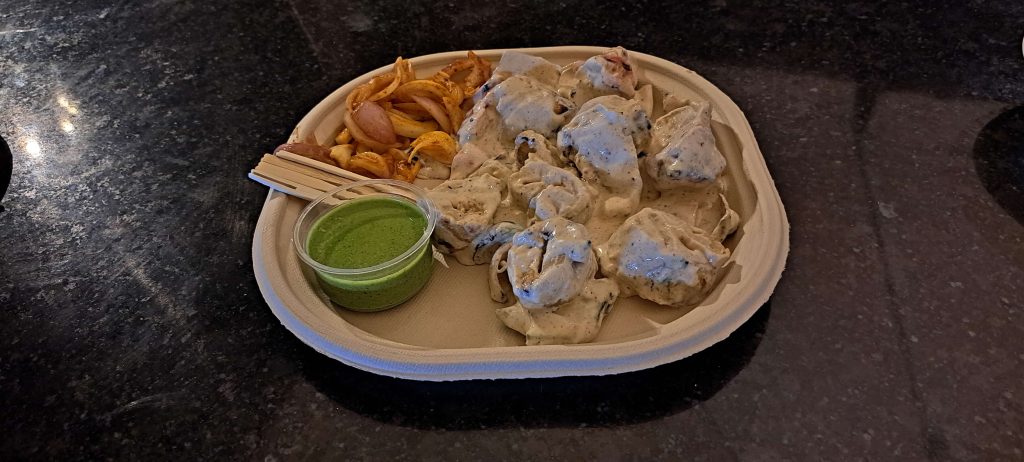
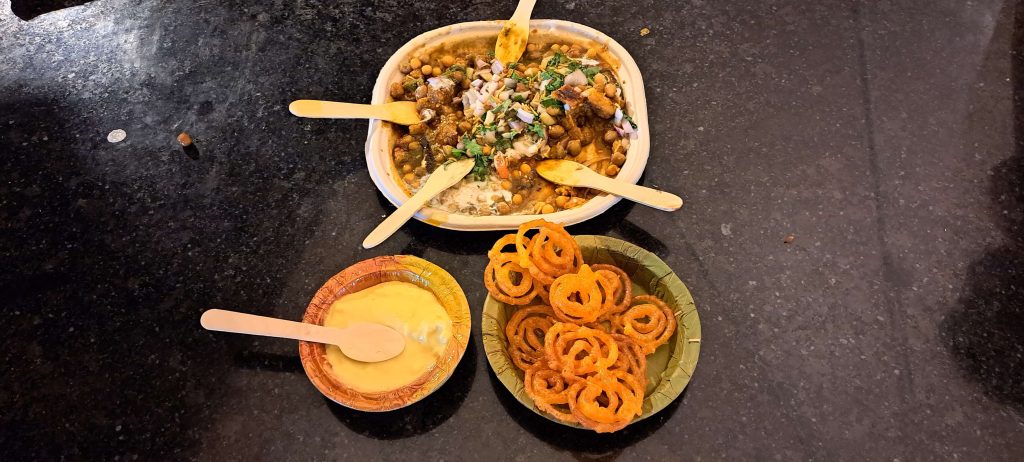
Day 1 – Albert Hall Museum and Nahargarh Fort
Albert Hall Museum
Next day (officially the first day of our trip) marked the start of our exploration of the place. First task was naturally, to hire a transport. It didn’t take a lot of efforts as the local autorickshaw drivers and tour guides were already waiting outside the hotel in anticipation. It was quite obvious given that the holiday season was on. We preferred an autorickshaw to a cab for two reasons. First was obviously the cost, since we needed to hire him for the entire day. Secondly, autorickshaws can make their way swiftly through the city traffic compared to the cabs.
Tip: You need to bargain hard with the locals for the transport since they are known to coax you into paying more than usual, especially during the holiday season.
First stop of the day was at the Albert Hall museum. Situated at the Ram Niwas garden outside the city wall, the museum houses an exotic collection of local as well as international art from countries like Sri Lanka, Japan, Myanmar among others. We were awestruck with the vibrant interiors as we passed through a maze of corridors leading to spacious halls that displayed the exhibits.
The architecture is a fine example of the Indo-Islamic architecture and the building is made up of stone and marble. The intricate carvings and design on the walls and the arches portray the delicate craftmanship of the local artisans. The exhibits, that include some of the beautiful paintings, sculptures made of ivory, wood and stone are bound to capture your eyeballs.
After spending almost an hour, admiring the beautiful works of art, we made our way out for our next destination – Jantar Mantar.

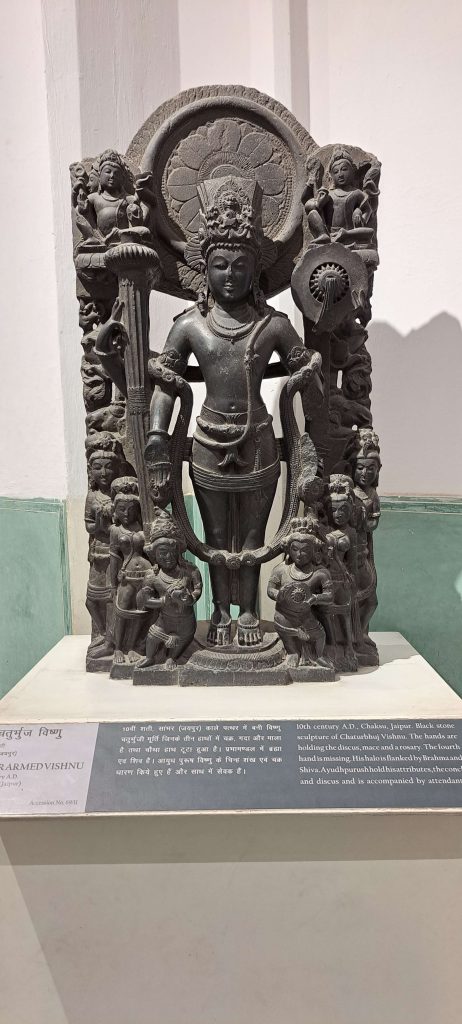
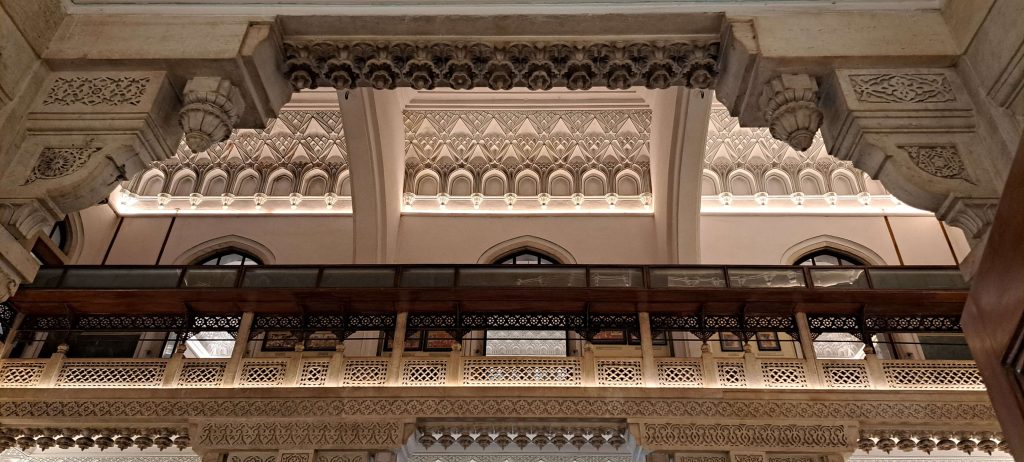
Jantar Mantar
Since our autorickshaw driver was also a makeshift tour guide, we were blindly following his directions. On the way to the Jantar Mantar, we made a brief halt at the Hawa Mahal. The driver told us that the structure is just a series of windows built for the royal ladies to allow them to have a glimpse of the daily life outside on the street without being seen. He also suggested that it is not worth spending time. Not sure whether we did right or wrong by listening to him, but we just clicked a few pictures outside the structure and move ahead to Jantar Mantar.

Jantar Mantar is a collection of 19 structures that are astronomical instruments built in the year 1734 by Maharaja Sawai Jai Singh to calculate the coordinates of celestial bodies. Though we did not get into the details of what each of those were meant for (since we were also exploring by ourselves without a proper guide), we were astonished by the fact that even today, three centuries after they were built, they continue to measure positions of celestial bodies with the same precision. We couldn’t help but admire the scientific progress in India in those days and surely made us proud of being an Indian.


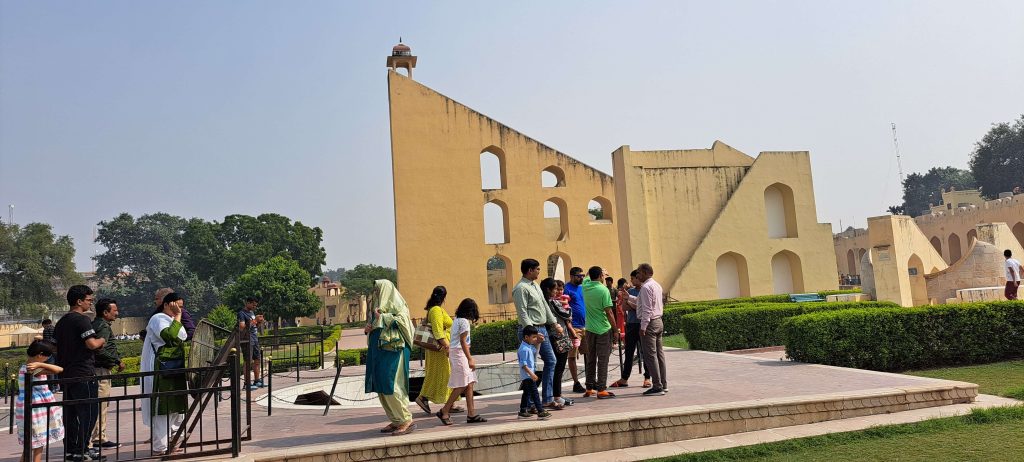

Nahargarh Fort
Rajasthan has always been a land of Rajas, which means “Kings”, and hence the name Rajasthan. There is no dearth of forts in Rajasthan and Jaipur is no exception to that. Out of the total 84 forts in Rajasthan, 3 are in Jaipur itself.
Narhargarh fort was the first fort on our itinerary. The distance between Jantar Mantar and Nahargarh fort is about 14 kms and takes around an hour to hour and a half to reach depending on the mode of transport. It was already half past one in the noon when we left from Jantar Mantar and were hungry enough.

We stopped at a local restaurant en-route to the fort. Though the restaurant did not have best of the ambiences, it did attract a decent crowd of tourists. We chose the restaurant since we wanted to try the popular local delicacies – Dal Baati Churma and Gatte ki Sabzi. The food did seem a bit more oily than usual, but tasty nonetheless.
We reached the entrance of the fort at around half past three in the afternoon. After buying entry tickets for the four of us, we proceeded with exploration of the fort.
Tip: Almost all the sightseeing destinations in Jaipur have entry fees. Though you can pay digitally at some of the locations, it is highly recommended you carry enough cash with you since the network connectivity can be an issue at some places.
We did not find much to explore inside the fort except for Madhavendra Bhawan, a palace that was an abode of Maharaja Sawai Madho Singh and a wax museum that also has a Seesh Mahal (house of mirrors) which was overly priced at Rs. 500 per person. However, since there was not much to do at the fort, we decided to spend some time at the museum, despite the fact that we had to shell out 2000 bucks for the same. But I have to say that we weren’t disappointed at all and had some good time at the museum. The kids enjoyed the puppet show and learnt some pottery skills as well.



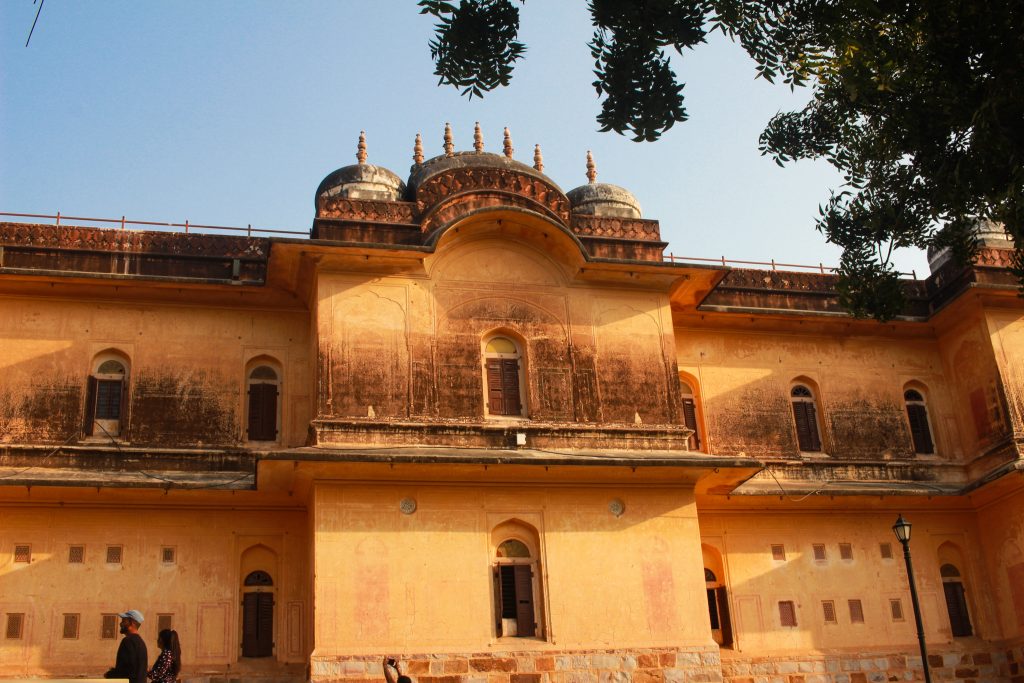
Kanak Ghati Garden
It was towards the fag end of the day, just when the sun had crossed the horizon, we were looking for a place to relax our tired feet. That is when our driver-cum-guide drove us to a serene location, by the name Kanak Ghati Garden. It felt so soothing to walk barefoot on the lush green grass as we entered the garden. Since it was almost time for closure, there weren’t too many tourists around, which gave us the relaxation we desperately needed. We just walked around for a while, spotted a couple of peahens and called it a day.

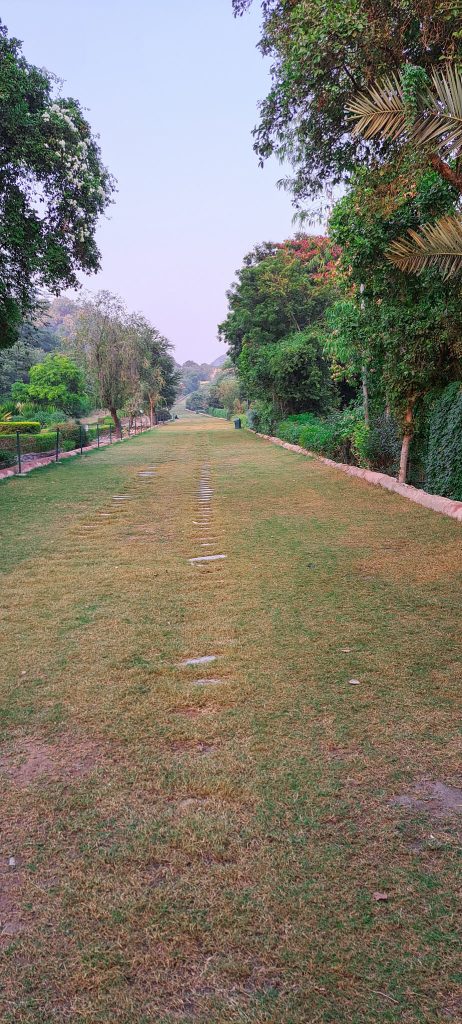

Day 2 – Amer Fort and Nahargarh Biological Park
Panna Meena ka Kund
Second fort on our itinerary was Amer fort which is by far the most popular and the most beautiful fort in Jaipur. The distance from our hotel was approximately 12 kms and took us almost an hour to reach by autorickshaw. However, we took a brief halt at place just before the fort, popularly known as Panna Meena ka Kund. It is a step-well that has a unique crisscross pattern of stairs. It was built in the 16th century as a water reservoir where rain water was harvested. The well still serves as a water source for the local town. For some reason, the security guards watching over the place did not allow us to descend the stairs and hence we had to be content taking a few photographs from the top of the well.
Without wasting more time, we proceeded towards the fort.
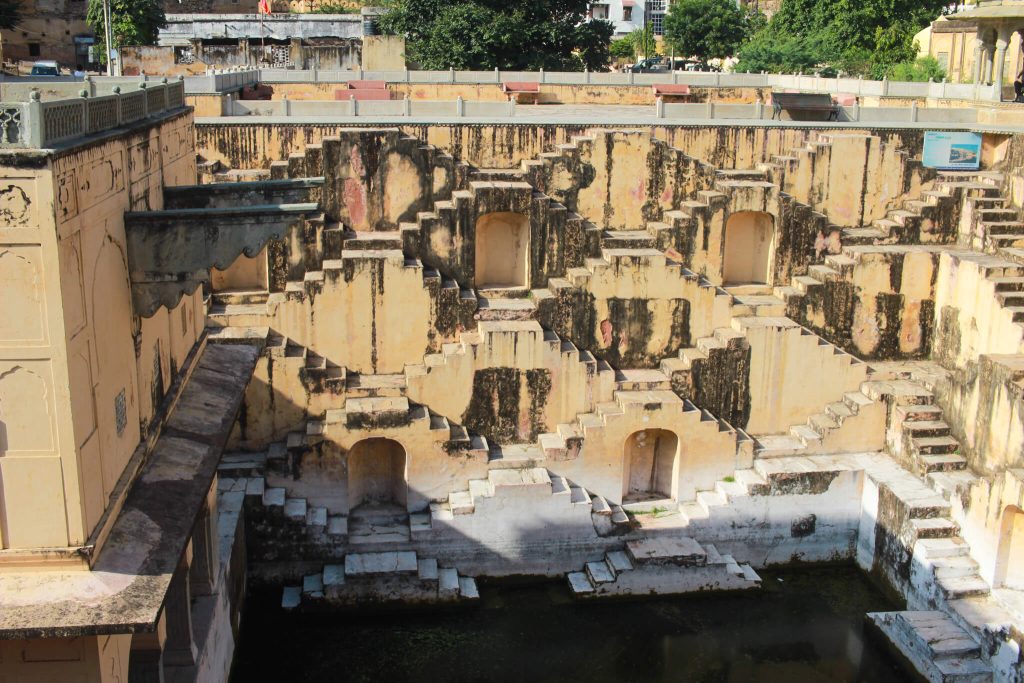
Amer Fort
From the moment we entered the main gate into the huge main courtyard surrounded by the castle walls, we were dumbstruck at the opulence and the grandeur of the place. The timeless beauty of the structures took us five hundred years back into the past, when the fort was built by the great Raja Man Singh, the first.
The entire fort is a maze of corridors that open up to the courtyards, each with a different layout and built for a different purpose, and also narrow, dimly lit passageways leading to various rooms. There is a lot of artwork to be admired and the beautiful blend of Rajput and Mughal architecture to be marveled at. However, despite all the splendour and glory, I couldn’t help but get an eerie vibe, may be because of the dark history around the places like these, and I wouldn’t definitely want to be the one to get lost and trapped inside after dark 😉
Tip: You need to carefully follow the signboards showing directions towards the exit or else you are bound to get lost inside.
Since the fort is also a tourist attraction, there are facilities like a bank ATM, Refreshments and Restrooms near the main gate. There is an art gallery as well, where you can buy some of the fine local handicraft exhibits.





Nahargarh Biological Park
From Amer fort, at around 6 kms to the north, is Nahargarh Biological Park (basically a zoo), sprawling across almost 1780 acres of land. Though there are options for vehicles to show you around inside the park, we preferred walking around. We didn’t want to cover the entire area of the park, since it would have been a time consuming affair. Not sure if November is a good time to visit the park, since most of the animals preferred staying in their hideouts were seldom sighted.
We thought the real fun would have been the Lion Safari. However, the other visitors to the park seemed less interested in the safari and hence opted out. The drivers of the vehicles used for the Safari refused to ply without the minimum occupancy of eight passengers. And looking at the cost they were charging for hiring the entire vehicle just for ourselves for the safari, was not worth the effort. So we ditched the Safari and headed back to the hotel.

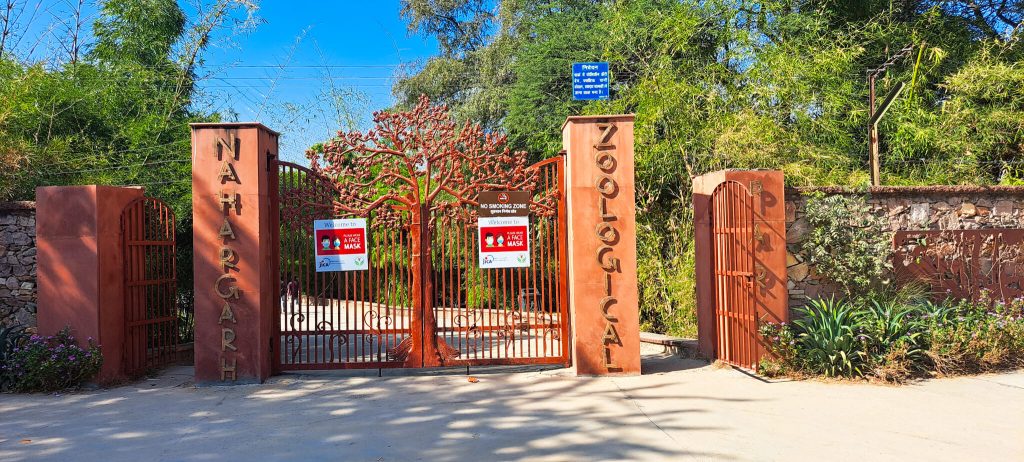

Tip: If you are staying in a hotel near the Mirza Ismail road, try out the delicious Mutton Kebabs at The Old Take Away Kabab Shop.
Day 3 – Kishangarh and Ajmer Dargah
Kishangarh
Who would imagine that a dumpyard can ever turn into a scenic landscape worth capturing in the camera? Well, Kishangarh marble dumpyard is just that.
A dumpyard for the leftover from the nearby Marble factories, Kishangarh has become a highly sought after destination for picturesque photo shoots in no time. Tourists from all over the country throng the place for its beautiful white carpet of marble dust and green water ponds. A perfect backdrop for a pre-wedding photoshoot or mind blowing selfies for your Instagram portfolio.
Kishangarh is about 90 kms from Jaipur on the way to Ajmer. There are various options to reach Kishangarh from Jaipur, however we decided to be more adventurous and opted for the state bus transport. Not a bad choice though, except for the rush and occasional stares from the local passengers.
It took us almost two and half hours to reach the Kishangarh bus depot. Then from the depot we had to take four seater rickshaw to the dumpyard, though the fares were a bit exorbitant. But we were really starved of choices.
We reached the dumpyard at around fifteen past three in the afternoon. Though the sight in front of us was mesmerizing, the heat was torterous.
Tip: Best time to spend a good quality time at the dumpyard is between 10 a.m to 12 p.m. or between 4 p.m. to 6 p.m. The temperatures around mid-day can drain you out, especially if you are visiting the place during summers.


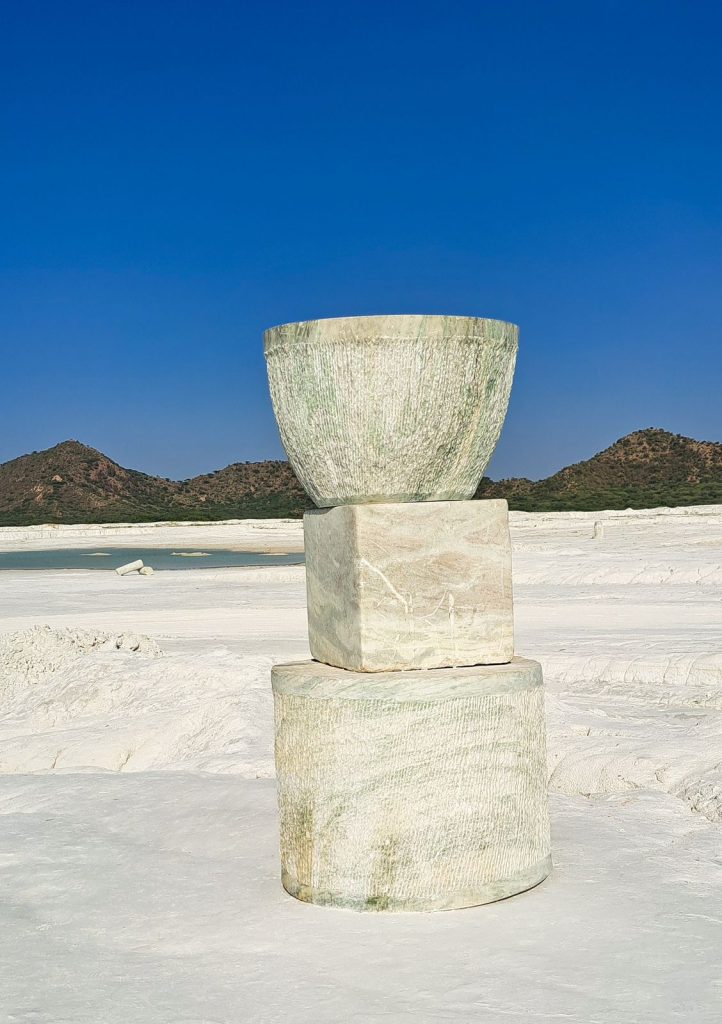
The white marble powdery waste actually looks like snow. Many of my friends to whom I showed the photographs later, actually believed we were either at Ladakh or some place in the Himachals!
After clicking a bunch of selfies and family photographs, we called it a day at Kishangarh.
Ajmer Dargah
The plan was to head back to Jaipur. However, when we reached the Kishangarh bus depot, we thought it would be a miss of we don’t make it to Ajmer Dargah after coming this close.
The kids were tired. But even though reluctantly, they still agreed and we got on a bus to Ajmer instead of Jaipur.
We reached Ajmer bus depot at around fifteen past five in the evening. We had to hire an autorickshaw from there to the dargah. The driver dropped us outside the main entrance to the lane that leads to the mosque.
The lane was crowded with tourists and devotees alike. The air was full of a sweet and spicy fragrance rising from the perfume shops lined up to our left and Moghlai restaurants to our right. I actually got a feeling of being in the territory of Nawabs!
We entered the main gate of the mosque and as expected, saw the place to be swarmed with local visitors as well as tourists. Just when we thought we will not be able to make it to the mazaar, a kind gentleman approached us and offered to take us straight to the mazaar (albeit for some money). We were initially reluctant but finally agreed. The gentleman swiftly made his way through the crowd and helped us reach the mazaar in no time, thereby skipping the long queue.
After taking the blessings of baba Hazrat Syed Noimuddin Chishty, we departed. We were really thankful to the hospitality bestowed upon us by the kind hearted gentleman. No religion, no caste, just pure faith in humanity!
Tip: Wear clothes that cover your entire body while you are visiting the dargah, else you may be denied an entry. Avoid clothes like shorts, skirts, etc.

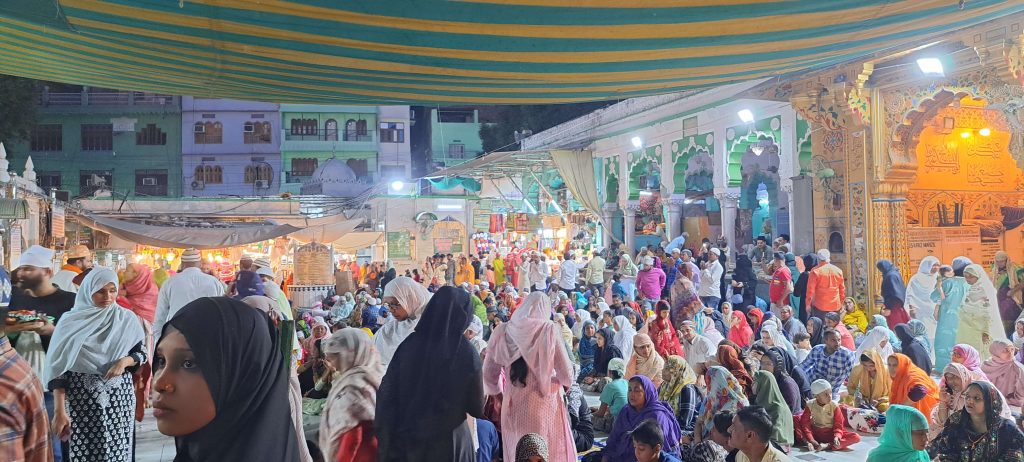

Day 4 – Rawat ki Kachori and Patrika Gate
Rawat ki Kachori
It’s considered a sin if you are visiting Jaipur and if you don’t try Rawat ki Kachori. Jokes apart, but Rawat Misthan Bhandar is a popular sweet shop at Sindhi camp, Station Road and is well known for local delicacies like Pyaaz Kachori, Daal Kachori, Mawa Kachori and Ghewar among others.
Since it was our last day at Jaipur, we didn’t want to drain our energies in yet another day-long sightseeing. We just decided to shop around and unwind a bit. There was still quite a lot to see in the city, but we were short of time.
Since I wanted to buy Ghewar for my brothers back home, the first thing we did was visit the Rawat Misthan Bhandar. While the Ghewar was getting packaged, we relished some Daal kachori and Pyaaz Kachori. Our tastebuds were tantalized by the spicy and tangy kachoris.
Once we were full, we headed for some more shopping for local handmade clothes and shoes. After spending an hour shopping, we were back at the hotel.
Patrika Gate
The last destination in our itinerary was Patrika Gate. We were wondering what should be our last destination and went through a list of probable options. However, since all the other destinations were at quite a distance from the hotel, we struck out those options and Patrika Gate was the only choice. One of the hotel staffs suggested we visit it in the evening as we would be able to enjoy the laser show and the dancing fountains.
We reached Patrika Gate by 7 p.m., just in time for the show. And what an experience we had that evening! The laser show was quite captivating and the dancing fountains were a visual spectacle! We were grateful to the hotel staff for such a valuable suggestion! The structure of the gate and the interiors are stunning, especially when lit up in the dark. The gate serves as an entrance to the Jawahar Circle Garden.


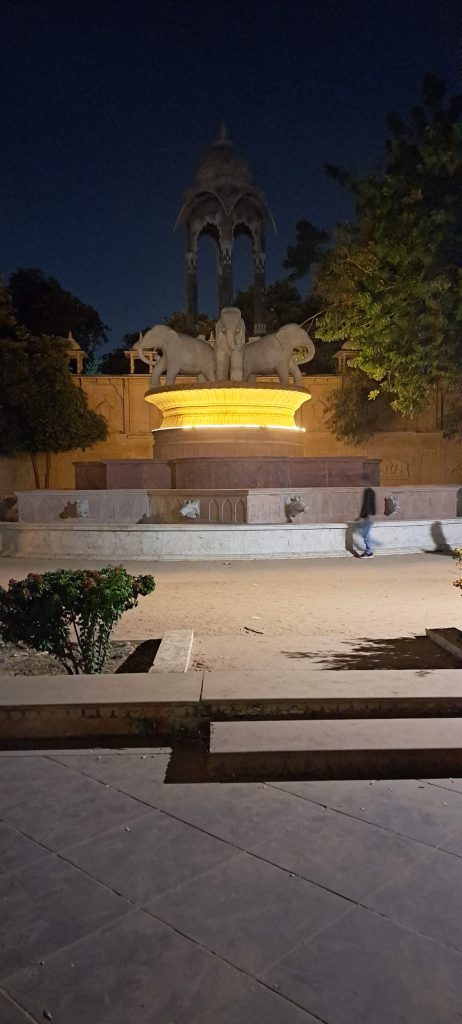

Except for the laser show and the dancing fountains, there is nothing much you can do post the sunset at the venue. After the show was over, we just strolled around for some time and returned back to the hotel in time, so that we get a good night sleep as we had a flight to catch the next morning.
Concluding Note
Rajasthan has a rich cultural history. The grand monuments built by the royal families of the past are a testament to it. You can’t help but admire the grandeur, no matter which part of the State you are in. Royalty is built into the very fabric of Rajasthan. Though the State administration has successfully preserved the cultural heritage, it has also ensured that the development isn’t impacted due to it.
Jaipur is as contemporary as it can get. It’s a place where the past meets future. At one end you can see memorials, palaces and forts standing the test of time for centuries. And at the other end you can see a bustling metropolis with state-of-the-art infrastructure racing towards the future. This diversity beautifully exemplifies the cultural ethos of the city.
Enriched with yet another memorable experience, we left the city, eagerly looking forward to many more.
In the meanwhile, my love affair with Rajasthan continues….


